MaryAnn Bernal's Blog, page 289
April 23, 2014
Diane Turner - London Rocks - 23.04.2014
Published on April 23, 2014 14:45
The Phil Naessens Show: Trading Ike Davis, Paying NCAA Athletes and the Milwaukee Brewers
http://phillipnaessens.wordpress.com/2014/04/23/the-phil-naessens-show-trading-ike-davis-paying-ncaa-athletes-and-the-milwaukee-brewers/

On today’s Phil Naessens Show Mark Berman joins Phil to discuss the New York Mets trading Ike Davis, Matt Harvey and the more Mets news. Joe Mullinax joins Phil to discuss whether or not NCAA athletes should be financially compensated and Mr. Brewtown joins Phil to discuss the first place Milwaukee Brewers.

On today’s Phil Naessens Show Mark Berman joins Phil to discuss the New York Mets trading Ike Davis, Matt Harvey and the more Mets news. Joe Mullinax joins Phil to discuss whether or not NCAA athletes should be financially compensated and Mr. Brewtown joins Phil to discuss the first place Milwaukee Brewers.

Published on April 23, 2014 08:24
KINDLE FREEBIE - Princess Alexia and the Dragon by K. Meador - April 23 and 24, 2014

Follow Princess Alexia as she and her brave dog, Zoey, as they embark on a mission to confront a fire-breathing dragon. She hopes to do what her father’s soldiers could not, capture the dragon so another Ample Apple Orchard celebration would not be attacked and the land set ablaze.
When Princess Alexia faces her adversary, she is frightened, but her fears abate once she and Titus, the dragon, begin talking. Can she convince Titus to stop plaguing her father’s kingdom, and will the festival be celebrated without fear of destruction?
Amazon US
http://www.amazon.com/Princess-Alexia-Dragon-K-Meador-ebook/dp/B00ISGD866/ref=sr_1_1?ie=UTF8&qid=1397176934&sr=8-1&keywords=Princess+alexia+and+the+dragon
Amazon UK
http://www.amazon.co.uk/Princess-Alexia-Dragon-K-Meador-ebook/dp/B00ISGD866/ref=sr_1_1?ie=UTF8&qid=1397177023&sr=8-1&keywords=princess+alexia+and+the+dragon

Published on April 23, 2014 05:17
History Trivia -Battle of Clontarf Brian Boru defeats Viking invaders
April 23
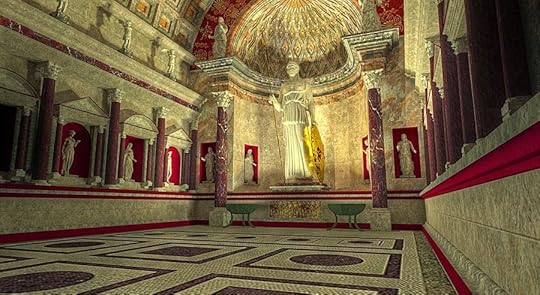
215 BC A temple was built on the Capitoline Hill and dedicated to Venus Erycina to commemorate the Roman defeat at Lake Trasimene.
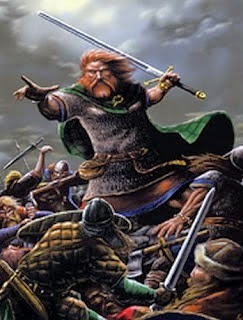
1014 Battle of Clontarf Brian Boru (High King of Ireland in 1002) defeated Viking invaders, but was killed during the battle.
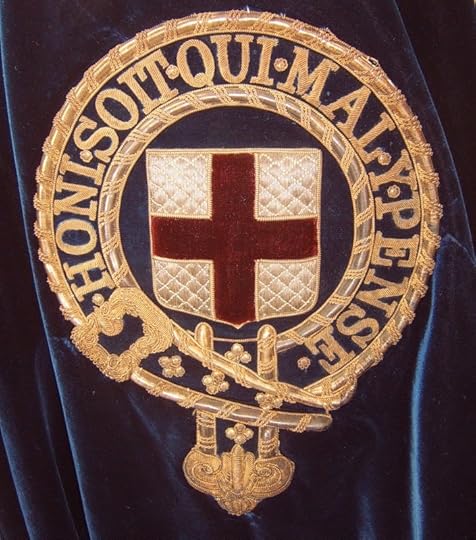
1348 The founding of the Order of the Garter by King Edward III was announced on St George's Day.

215 BC A temple was built on the Capitoline Hill and dedicated to Venus Erycina to commemorate the Roman defeat at Lake Trasimene.

1014 Battle of Clontarf Brian Boru (High King of Ireland in 1002) defeated Viking invaders, but was killed during the battle.

1348 The founding of the Order of the Garter by King Edward III was announced on St George's Day.

Published on April 23, 2014 05:16
April 22, 2014
Mr. Chuckles was around The Wizard's Cauldron checking out Welsh chickliterati Karenne Griffin

The Wizard says:
Around the Cauldron today we have Karenne Griffin, Australian by birth (Tasmanian, actually), but now as staunchly welsh as Charlotte Church, Robbie Savage and original rebel, Owen Glendower. She writes chicklit set in the valleys and villages of where she lives.
Karenne is a lover of life and always seems to be at a party, a wedding or down the pub for a few pints of Skull Attack and so I was lucky to track her down.
Want more of Karenne - click on the link
http://greenwizard62.blogspot.com/2014/04/karenne-griffin-welsh-chickliterati.html

Published on April 22, 2014 15:17
Ancient Assassin Flies Found in Amber
By Megan Gannon, News Editor
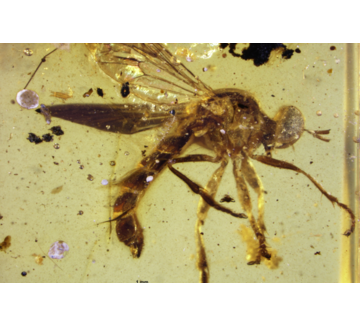 A scientist at the Smithsonian National Museum of Natural History discovered and named a new 100-million-year-old species of assassin fly, Burmapogon bruckschi, after studying the first two specimens ever preserved in Burmese amber.
A scientist at the Smithsonian National Museum of Natural History discovered and named a new 100-million-year-old species of assassin fly, Burmapogon bruckschi, after studying the first two specimens ever preserved in Burmese amber.
Credit: David Grimaldi
[image error] An extinct species of assassin fly that lived during the age of the dinosaurs has been discovered inside a translucent tomb of amber. A male and a female of the newfound species, now called Burmapogon bruckschi, were preserved in pieces of Burmese amber from Myanmar's Hukawng Valley. The specimens measure less than an inch (2.5 centimeters) in length and are about 100 million years old, researchers say.
B. bruckschi joins more than 7,500 species of assassin flies that are alive today. The insects get their name from their precise and gruesome way of killing: After a mid-flight ambush, assassin flies stab their prey's exoskeleton and inject digestive juices so that they can suck out the liquefied insides like a milkshake, leaving an empty hull behind.
But apparently, these two tiny predators weren't immune to oozing droplets of resin. Insects can become trapped in amber when they are engulfed in resin flowing from trees. Hardened amber droplets can thus provide rare snapshots of prehistoric life — and some of them are surprisingly rich scenes, like a spider attacking a wasp caught in its web.
Previously, the history of assassin flies had been recorded only in limestone fossils. The amber-encased B. bruckschi specimens provide a rare 3D view of the ancient creatures' bodies.
"The transparency of these amber fossils gives researchers a new window into the ecology of the Cretaceous Period, and sheds light on the evolutionary history of a family of flies that has withstood the test of time for millions of years," Torsten Dikow, a scientist at the Smithsonian National Museum of Natural History who discovered the species, said in a statement. "The fossils of these ancient flies are so well preserved that you can almost imagine them flying around in our world today."
Dikow identified a few features that set B. bruckschi apart from its living cousins: flattened antennae, a V-shaped eye structure, spiny hind legs and bristles covering its piercing mouthparts.
The species, along with another type of ancient assassin fly, Cretagaster raritanensis, was described in yesterday's (April 21) edition of the journal American Museum Novitates. This second creature was only recently identified as a new species; it was originally found in a chunk of amber in New Jersey in 1999.
http://www.livescience.com/44998-ancient-assassin-flies-found-in-amber.html
 A scientist at the Smithsonian National Museum of Natural History discovered and named a new 100-million-year-old species of assassin fly, Burmapogon bruckschi, after studying the first two specimens ever preserved in Burmese amber.
A scientist at the Smithsonian National Museum of Natural History discovered and named a new 100-million-year-old species of assassin fly, Burmapogon bruckschi, after studying the first two specimens ever preserved in Burmese amber. Credit: David Grimaldi
[image error] An extinct species of assassin fly that lived during the age of the dinosaurs has been discovered inside a translucent tomb of amber. A male and a female of the newfound species, now called Burmapogon bruckschi, were preserved in pieces of Burmese amber from Myanmar's Hukawng Valley. The specimens measure less than an inch (2.5 centimeters) in length and are about 100 million years old, researchers say.
B. bruckschi joins more than 7,500 species of assassin flies that are alive today. The insects get their name from their precise and gruesome way of killing: After a mid-flight ambush, assassin flies stab their prey's exoskeleton and inject digestive juices so that they can suck out the liquefied insides like a milkshake, leaving an empty hull behind.
But apparently, these two tiny predators weren't immune to oozing droplets of resin. Insects can become trapped in amber when they are engulfed in resin flowing from trees. Hardened amber droplets can thus provide rare snapshots of prehistoric life — and some of them are surprisingly rich scenes, like a spider attacking a wasp caught in its web.
Previously, the history of assassin flies had been recorded only in limestone fossils. The amber-encased B. bruckschi specimens provide a rare 3D view of the ancient creatures' bodies.
"The transparency of these amber fossils gives researchers a new window into the ecology of the Cretaceous Period, and sheds light on the evolutionary history of a family of flies that has withstood the test of time for millions of years," Torsten Dikow, a scientist at the Smithsonian National Museum of Natural History who discovered the species, said in a statement. "The fossils of these ancient flies are so well preserved that you can almost imagine them flying around in our world today."
Dikow identified a few features that set B. bruckschi apart from its living cousins: flattened antennae, a V-shaped eye structure, spiny hind legs and bristles covering its piercing mouthparts.
The species, along with another type of ancient assassin fly, Cretagaster raritanensis, was described in yesterday's (April 21) edition of the journal American Museum Novitates. This second creature was only recently identified as a new species; it was originally found in a chunk of amber in New Jersey in 1999.
http://www.livescience.com/44998-ancient-assassin-flies-found-in-amber.html

Published on April 22, 2014 10:05
Ancient Rome's tap water heavily contaminated with lead, researchers say
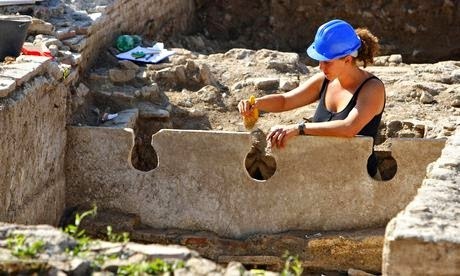 An archaeologist works at Portus: scientists inferred levels of lead pollution in the Roman water supply by analysing sediment cores taken from the Trajanic harbour basin. Photograph: Chris Ison/PA
An archaeologist works at Portus: scientists inferred levels of lead pollution in the Roman water supply by analysing sediment cores taken from the Trajanic harbour basin. Photograph: Chris Ison/PASupply became contaminated as it passed through giant network of lead pipes that distributed water around city, scientists believe
Ian Sample, science correspondent
Tap water in ancient Rome, provided by its famous aqueducts, was contaminated with up to 100 times more lead than local spring water, researchers say.
Huge volumes of fresh water flowed along aqueducts to the heart of the Roman empire but the supply was contaminated as it passed through the giant network of lead pipes that distributed water around the city.
Researchers in France said levels of lead in Roman drinking water were a concern, but were probably insufficient to cause widespread mental problems, or potentially drive up crime rates, through lead poisoning.
"It's marginal. You would start being worried about drinking that water all your life," said Francis Albarède, who led the study at Claude Bernard University in Lyon. "Even though they probably did not get degenerate, as some people say, or even get more violent, lead pollution might have been something to be concerned about."
The scientists inferred lead pollution levels by analysing sediment cores taken from the Trajanic harbour basin at Portus, a major port of imperial Rome, and a canal that connected the port to the Tiber river.
The Trajanic harbour, a hexagonal inland basin, was built in the early years of the second century AD to give safe mooring to merchant ships as the population of Rome expanded.
Albarède's team studied lead isotopes in a nine-metre-deep core drilled from the harbour and a 13-metre core taken from the canal, which carried a record of contaminants from the Tiber. Sediments trap contaminants as they form, so studies of sediment cores drilled from ocean floors and river beds can reveal levels of environmental pollution dating back hundreds or thousands of years.
The tests on the Tiber sediments were striking. They showed that two kinds of water mixed in the river. The first was natural river water, which carried lead isotopes originally from the Apennines and volcanic rock in the Alban hills south-east of Rome.
The second type was much cleaner drinking water, that had drained into the river, and was contaminated with isotopes of lead not found in Italy. The researchers believe the lead was mined elsewhere, perhaps in Eifel in Germany, or even the English Pennines, and then brought back in ingots to make lead piping.
Further tests on the sediments showed that levels of lead in the Roman tap water varied over time from 14 to 105 times higher than those found in natural spring water. The findings are reported in the Proceedings of the National Academy of Sciences.
Though Rome's complex plumbing system gave officials control over the distribution of water around the city, it was not unknown for locals to punch holes in the pipes to draw water off, increasing the number of people exposed to the lead. Even so, Albarède believes that any health problems caused by lead piping could not have brought the civilisation to its knees.
"Can you really poison an entire civilisation with lead? I think it would take more than lead piping in Rome to do that," he said.
http://www.theguardian.com/science/2014/apr/21/ancient-rome-tap-water-contaminated-lead-researchers

Published on April 22, 2014 09:57
The Briton and the Dane Concordia featured on eBookSoda
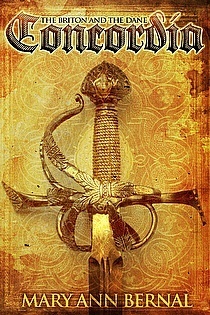
The Briton and the Dane: Concordiaby Mary Ann BernalStunning historical romantic adventureBeautiful noblewoman, Concordia, finds herself at the center of intrigue, betrayal and the vain desires of two egotistical brothers, each willing to die for her favor. Using only feminine cunning, Concordia must defend her honor while plotting her escape.Get it now$0.99 (£0.77) Amazon Kindle UK Amazon Kindle US http://www.ebooksoda.com/ebook-deals/the-briton-and-the-dane-concordia-by-mary-ann-bernal

Published on April 22, 2014 06:24
The Phil Naessens Show: Portland’s LeMarcus Aldridge is the Real Deal
http://phillipnaessens.wordpress.com/2014/04/22/the-phil-naessens-show-portlands-lemarcus-aldridge-is-the-real-deal/
 On today’s Phil Naessens Show Dave Deckard joins Phil to discuss the Portland Trailblazers upset win over the Houston Rockets, LeMarcus Aldridge, Damian Lillard and previews Wednesday night’s playoff game against Houston. Amar joins Phil to finish their discussion of ESPN 30 for 30 documentary Bad Boys and the guys share their thoughts on the playoffs thus far.
On today’s Phil Naessens Show Dave Deckard joins Phil to discuss the Portland Trailblazers upset win over the Houston Rockets, LeMarcus Aldridge, Damian Lillard and previews Wednesday night’s playoff game against Houston. Amar joins Phil to finish their discussion of ESPN 30 for 30 documentary Bad Boys and the guys share their thoughts on the playoffs thus far.

 On today’s Phil Naessens Show Dave Deckard joins Phil to discuss the Portland Trailblazers upset win over the Houston Rockets, LeMarcus Aldridge, Damian Lillard and previews Wednesday night’s playoff game against Houston. Amar joins Phil to finish their discussion of ESPN 30 for 30 documentary Bad Boys and the guys share their thoughts on the playoffs thus far.
On today’s Phil Naessens Show Dave Deckard joins Phil to discuss the Portland Trailblazers upset win over the Houston Rockets, LeMarcus Aldridge, Damian Lillard and previews Wednesday night’s playoff game against Houston. Amar joins Phil to finish their discussion of ESPN 30 for 30 documentary Bad Boys and the guys share their thoughts on the playoffs thus far.

Published on April 22, 2014 05:47
History Trivia - First stone of the Bastille laid
April 22

238 Year of the Six Emperors: The Roman Senate outlawed emperor Maximinus Thrax for his bloodthirsty proscriptions in Rome and nominated two of its members, Pupienus and Balbinus, to the throne.

960 Basil II was crowned Emperor of the Byzantine Empire.

1073 Gregory VII was elected pope. 1056 Supernova Crab nebula last seen by the naked eye.
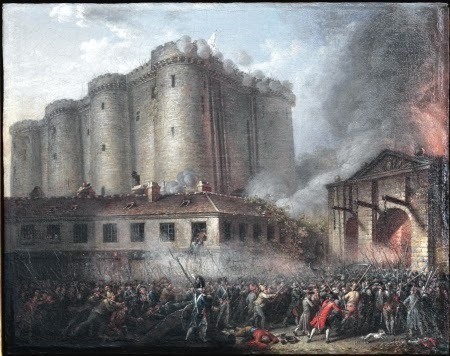
1370 First stone of the Bastille laid. The fortress that was later to become a prison was built on the orders of King Charles V of France. It was intended as a fortification to help protect the wall around Paris against English attack during the Hundred Years' War.


238 Year of the Six Emperors: The Roman Senate outlawed emperor Maximinus Thrax for his bloodthirsty proscriptions in Rome and nominated two of its members, Pupienus and Balbinus, to the throne.

960 Basil II was crowned Emperor of the Byzantine Empire.

1073 Gregory VII was elected pope. 1056 Supernova Crab nebula last seen by the naked eye.

1370 First stone of the Bastille laid. The fortress that was later to become a prison was built on the orders of King Charles V of France. It was intended as a fortification to help protect the wall around Paris against English attack during the Hundred Years' War.

Published on April 22, 2014 05:45




